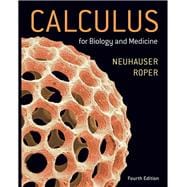NOTE: Before purchasing, check with your instructor to ensure you select the correct ISBN. Several versions of the MyLab™ and Mastering™ platforms exist for each title, and registrations are not transferable. To register for and use MyLab or Mastering, you may also need a Course ID, which your instructor will provide.
Used books, rentals, and purchases made outside of Pearson
If purchasing or renting from companies other than Pearson, the access codes for the MyLab platform may not be included, may be incorrect, or may be previously redeemed. Check with the seller before completing your purchase.
For freshman-level, two-semester or three-semester courses in Calculus for Life Sciences.
This package includes MyLab Math.
Shows students how calculus is used to analyze phenomena in nature – while providing flexibility for instructors to teach at their desired level of rigor
Calculus for Biology and Medicine motivates life and health science majors to learn calculus through relevant and strategically placed applications to their chosen fields. It presents the calculus in such a way that the level of rigor can be adjusted to meet the specific needs of the audience – from a purely applied course to one that matches the rigor of the standard calculus track.
In the 4th Edition, new co-author Marcus Roper (UCLA) partners with author Claudia Neuhauser to preserve these strengths while adding an unprecedented number of real applications and an infusion of modeling and technology.
Reach every student by pairing this text with MyLab Math
MyLab™ Math is the teaching and learning platform that empowers instructors to reach every student. By combining trusted author content with digital tools and a flexible platform, MyLab Math personalizes the learning experience and improves results for each student. For the first time, instructors teaching with Calculus for Biology and Medicine can assign text-specific online homework and other resources to students outside of the classroom.
0134845048 / 9780134845043 Calculus for Biology and Medicine plus MyLab Math with Pearson eText — Access Card Package, 4/e
Package consists of:
-
0134070046 / 9780134070049 Calculus for Biology and Medicine
-
0134782895 / 9780134782898 MyLab Math with Pearson eText - Standalone Access Card - for Calculus for Biology and Medicine, 4/e








